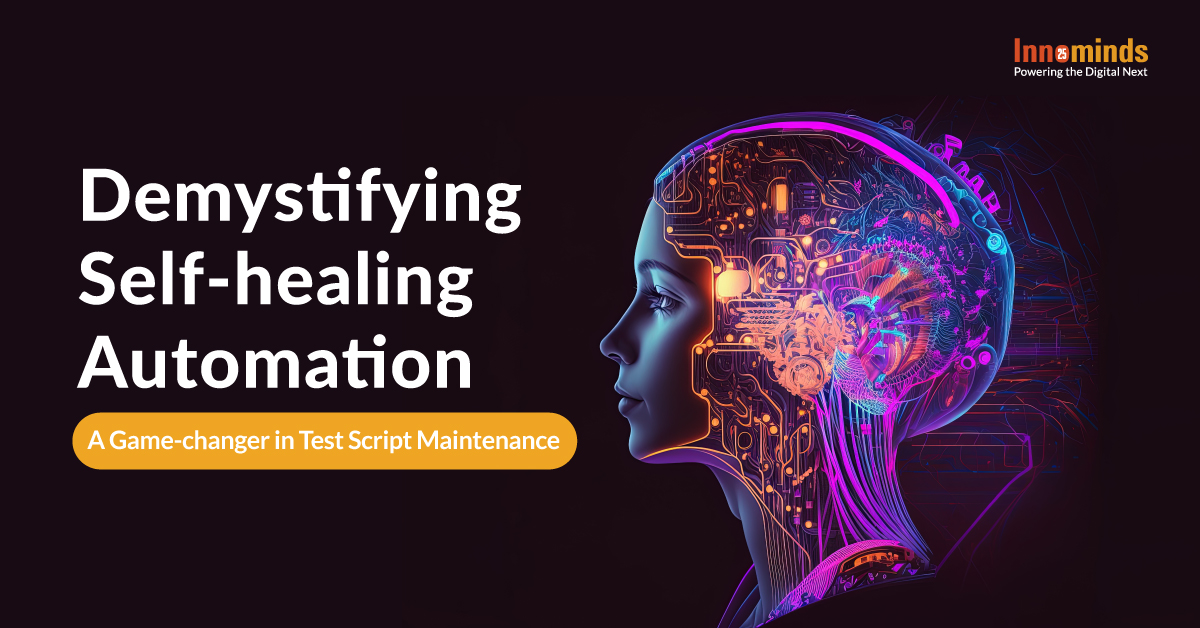Challenges with traditional automation:
Traditional test automation tools rely on object properties to identify objects within an application. When the application undergoes changes, however, such as updates or modifications, these object properties often change. Consequently, test scripts that depend on these properties may fail to execute successfully. This leads to a significant increase in the effort required for test script maintenance, making it a time-consuming task. Furthermore, this challenge places a burden on the test engineer, who needs to apply his expertise and expend effort to address these issues effectively.
What is self-healing test automation?
Self-healing is an innovative approach to address the above challenges. In traditional test automation, script failures occur when there are changes in the user interface object properties. That is no longer a problem with self-healing capabilities, as testing tools can proactively sense such property changes and automatically adapt the scripts during runtime. This intelligent feature enables the scripts to heal themselves by detecting modifications in object properties and seamlessly updating them with the new attributes. Consequently, the designed test cases remain functional even in the face of constantly evolving application interfaces. The primary goal of self-healing is to minimize the maintenance effort required to keep test scripts up-to-date and fully operational, empowering test engineers to focus on higher-value tasks rather than being burdened by routine script maintenance. By incorporating self-healing capabilities into test automation, organizations can significantly enhance the efficiency, reliability, and scalability of their testing processes.
Traditional Object Maintenance vs. Self-healing Object Maintenance:
-Jul-18-2023-11-22-59-6292-AM.png?width=1200&height=628&name=MicrosoftTeams-image%20(1)-Jul-18-2023-11-22-59-6292-AM.png)
Self-healing automation follows a series of steps to properly manage automated tests. These steps outline the seamless process through which the self-healing feature identifies and addresses changes in the application's interface, allowing for efficient and accurate test execution without the need for extensive manual intervention.
Step 1: The self-healing algorithm is triggered when an error like "NoSuchElement" occurs for an element mentioned in automation scripts.
Step 2: AI and machine learning algorithms thoroughly scan the user interface of the application under test, searching for existing objects.
Step 3: A comparison is made between the data collected from the search and the application model used in the automated tests.
Step 4: If any changes are detected in the application, the self-healing mechanism is activated automatically modify the necessary test components.
Step 5: As the self-healing automation executes, internal scripts autonomously correct themselves, as these changes are automatically identified.
Step 6: The self-healing tool proceeds to remap the objects, ensuring error-free test execution.
Limitations of Self-healing:
Self-healing in test automation indeed offers significant advantages, but it is important to be aware of its limitations. It is crucial to note the above limitations and consider them when implementing and relying on self-healing techniques in test automation. While self-healing can greatly improve maintenance efforts and reduce script failures, it is still essential to monitor and verify the accuracy of the automated tests to ensure reliable and meaningful results.
Consider the following factors:
Limited Contextual Understanding: Self-healing techniques may lack the contextual understanding required to handle all scenarios accurately. While they can identify and update elements that have changed, they may not always determine the correct action to take. This can result in false positives or incorrect fixes, requiring manual intervention to ensure the accuracy of the automated tests.
Non-Deterministic Changes: Some changes in the application under test (AUT) or the test environment may be non-deterministic or intentionally random. Elements with dynamic content or unpredictable identifiers can pose challenges for self-healing mechanisms. Adapting to and correctly identifying such elements can be difficult, as their behavior may vary across different test runs.
Complexity of Test Scenarios: Self-healing mechanisms are generally more effective at handling simple and straightforward changes in the AUT. For complex test scenarios that involve multiple interdependent steps or validations, the automated tests may struggle to adapt seamlessly. The complexity of the test logic can make it harder to determine the appropriate fix when a failure occurs, potentially requiring manual intervention to address the issue.
False Positives and False Negatives: False positives (detecting changes that haven't occurred) and false negatives (failing to detect actual changes) can undermine the effectiveness of self-healing in test automation. These issues can result in unnecessary updates or missed issues, impacting the reliability and accuracy of the tests. Regular monitoring and validation of self-healing mechanisms are crucial to minimize false indications.
Maintenance Effort and Overhead: Implementing and maintaining self-healing capabilities in test automation frameworks require additional effort and resources. The development and maintenance of the self-healing mechanisms can introduce overhead, especially in complex applications and test suites. It's important to weigh the benefits against the additional effort required to ensure it is a worthwhile investment.
Dependencies on External Tools or Libraries: Some self-healing techniques rely on external tools or libraries, which can introduce dependencies and compatibility issues. Integrating and managing these tools may add complexity to the test automation setup and potentially impact the stability and reliability of the tests. Careful consideration should be given to the selection and integration of external tools to minimize any negative impact.
Conclusion:
Self-healing automation can bring substantial value to test automation efforts. Yes, there are some limitations, but by reducing maintenance efforts and enhancing the resilience of test scripts, it contributes to more efficient and robust testing processes. Just remember, it is crucial to thoroughly assess the project's requirements and limitations before implementing self-healing techniques. This evaluation ensures that the chosen self-healing mechanisms align with the automation goals and effectively address the specific challenges faced. Additionally, regular monitoring, review, and adjustments are vital to maintain the effectiveness and reliability of self-healing mechanisms over time. By continuously refining and optimizing the self-healing capabilities, the benefits of automation can be maximized while mitigating potential limitations.





-Apr-17-2024-11-23-05-5270-AM.png?width=150&height=150&name=MicrosoftTeams-image%20(9)-Apr-17-2024-11-23-05-5270-AM.png)